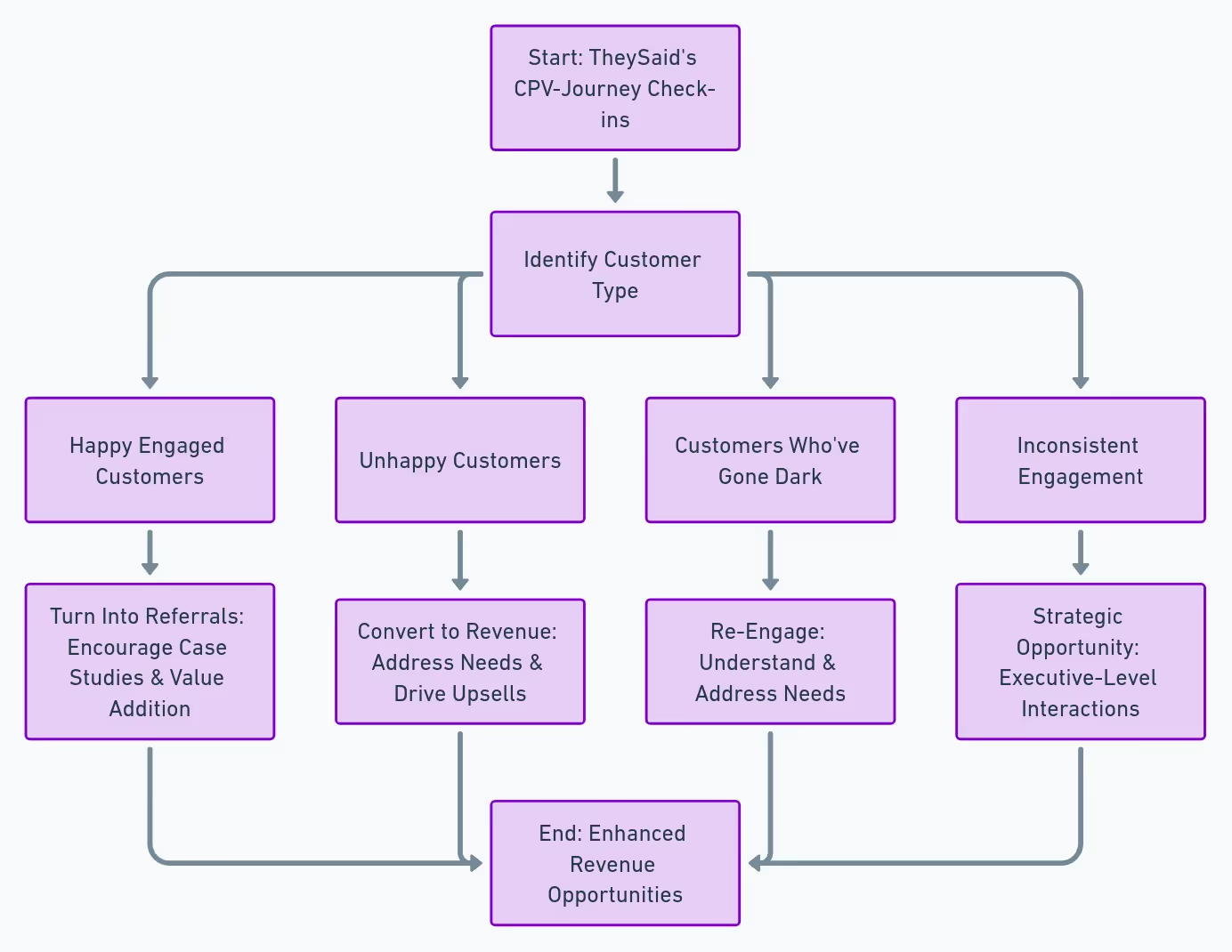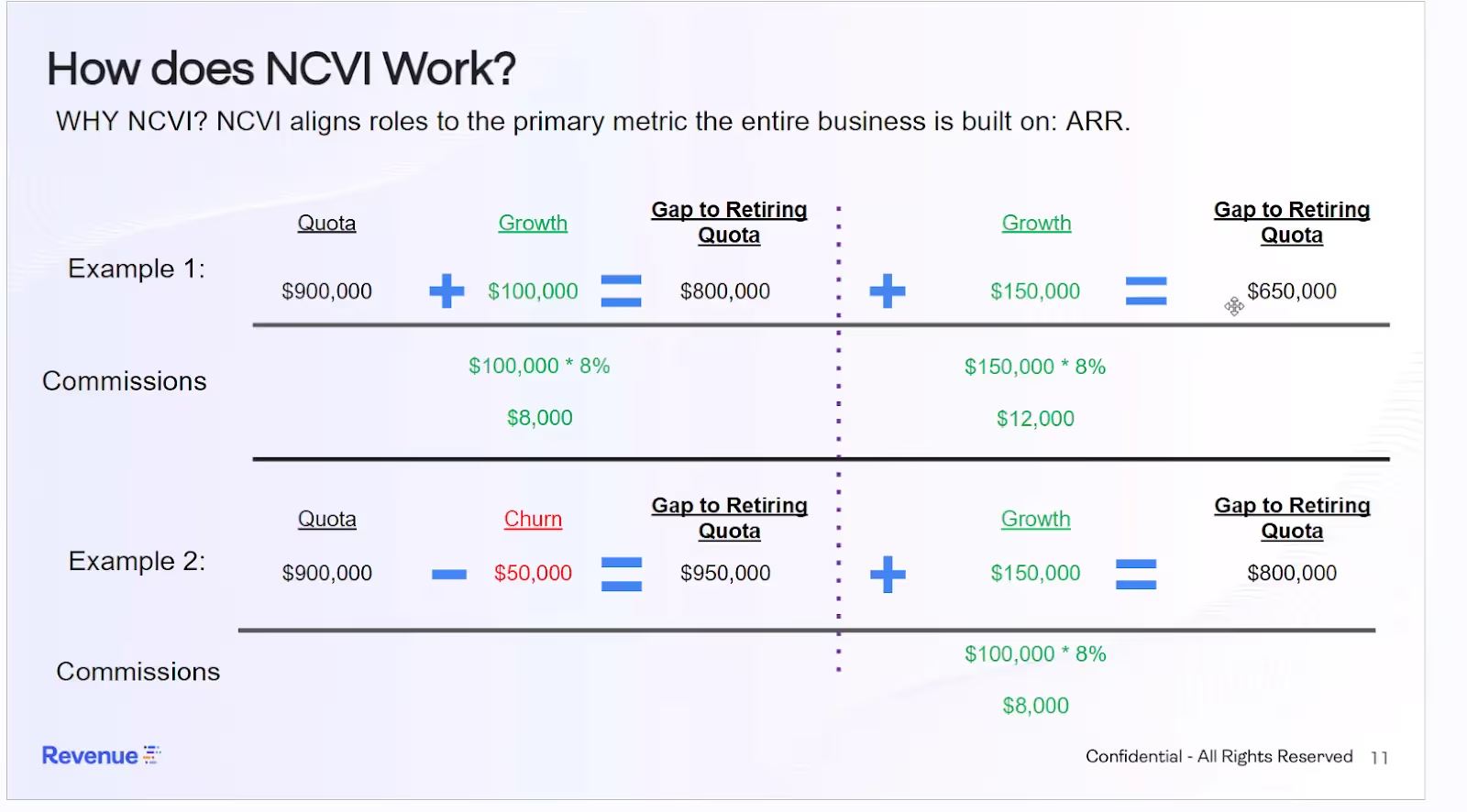 Blog
Blog Aligning Strategy and Incentives for Growth and Retention with Alastair Woolcock
Aligning Strategy and Incentives for Growth and Retention with Alastair WoolcockAligning Strategy and Incentives for Growth and Retention with Alastair Woolcock

FEATURING: Alastair Woolcock, Chief Strategy & Revenue Officer (CSRO) at Revenue.io
Throughout my journey from customer success to sales, one lesson has remained constant: alignment across teams is critical for driving growth and retention. Whether I was experimenting with AI, analyzing trends at Gartner, or shaping strategy in my current role, I’ve seen firsthand that keeping customers and growing their value requires a unified approach.
The Net Contract Value Increase (NCVI) model is a strategy I've come to champion, designed to boost the growth of existing customer accounts by aligning the incentives of customer success teams, account managers, and sales teams. Simply put, it's about making sure everyone involved with customer accounts is working towards not just keeping the business but actively growing it. More on this later.
Converting Churn into Revenue Growth
Churn, or customers leaving us, is always a big deal. But the way things have been changing lately really shows we need to do more than just try to keep customers from leaving. We need to turn those challenges into opportunities to grow existing revenue from customers. It’s important to pay attention to customers who might want to spend less with us instead of leaving altogether. This doesn't get enough attention today. Really understanding what our customers need at every stage of their journey with us and then taking proactive action on it is key to keeping our growth strong and steady.
Having a methodology of continuously and scalably checking in with customers like TheySaid’s CPV-Journey can help identify, segment and convert the four types of customers into new revenue opportunities:
- Happy engaged customers
- Unhappy customers
- Customers who have gone dark
- Inconsistently engaged customer

Step-by-step guide on an effective expansion strategy for AEs, AMs, and CSMs
Step 1: Strategic Account Mapping: Map the TAM
Identify Key Stakeholders: Beyond understanding the Total Addressable Market, identify and map out the key decision-makers and influencers within each account. This involves creating a hierarchy or influence map that highlights the relationships between different stakeholders and their impact on purchasing decisions.
Assess Needs and Opportunities: Use the TAM analysis to pinpoint specific areas where your products or services can address unmet needs or improve upon current solutions. This could involve personalized product demonstrations, tailored solutions, or strategic discussions on how your offerings align with their business goals.
Prioritize Accounts Based on Potential: Not all accounts are created equal. Use your TAM analysis to prioritize accounts based on their growth potential, strategic importance, and readiness to buy. This helps in allocating resources more effectively and focusing efforts where they can have the greatest impact.
Step 2: Upsells and Cross-sells Strategy, Definition and Ownership
Define Upsell and Cross-sell Strategies: Clearly define what constitutes an upsell versus a cross-sell within your organization. Upsells involve selling more of the same product or upgrading to a higher tier, while cross-sells introduce complementary products or services.
Tailor Communication and Offers: Customize your approach based on the type of sale. For upsells, focus on how additional features or services can enhance the customer's existing setup. For cross-sells, highlight the value of adding new products or services to their portfolio.
Define Ownership: Ensure that AMs, CSMs, and AEs know who owns each type of expansion strategy. Clear role definitions and understanding of responsibilities can prevent overlaps and ensure a cohesive customer experience.
Recommendation:
- Renewals and Upsells: AMs and CSMs
- Cross-sell: AEs
Step 3: Implement NCVI Commission Model to Unify Team Incentives
The Net Contract Value Increase (NCVI) model plays a pivotal role in bringing our teams together with a common goal: enhancing the value of our customer accounts. This model encourages everyone, from sales to customer success to account management, to work hand-in-hand. It's about creating a culture where the entire team is motivated to contribute to account growth, which in turn helps in significantly reducing churn and fostering a proactive, growth-oriented mindset. Click to download commission/ bonus calculator for CS, AM and Sales, it can be apply to a boarder team.
Step 4: Push for ERWU (Early Renewal with Upsell)
ERWU, or Early Renewal with Upsell, is a strategy that combines renewing customer contracts before they expire with offering upgrades or additional products. This approach is key for a few reasons:
- Boosts Loyalty: By renewing early, customers feel valued and are more likely to stay with your service.
- Increases Revenue: Upselling at renewal time can raise your earnings by selling more or better services to existing customers.
- Saves Time: Handling renewals and upsells together makes the process more efficient, cutting down on the need for separate discussions.
- Stabilizes Income: Knowing your revenue ahead of time helps with planning and making smart business decisions.
Redefining Success Metrics from NRR to Focus on Improving Customer’s Decision Confidence
The conventional metrics such as Net Promoter Scores (NPS) have their place, but my focus has shifted towards more indicative metrics like Net Revenue Retention (NRR) and Gross Dollar Retention (GDR). These metrics, however, only scratch the surface. The essence of my strategy is to measure 'decision confidence' among customers, a predictor I've found to be far more potent in forecasting long-term loyalty and expansion opportunities.
Improving customer confidence is critical to helping customers make bold, decisive purchases and establishing healthy, continually growing accounts. Decision confidence works because it builds a bridge from status quo to change, helping customers feel capable of overcoming challenges as they believe in themselves, their logic, their process and their decision-making skills.”
We strive to make our customers feel certain that partnering with us is the right choice. This involves more than just delivering great products or services; it's about demonstrating undeniable value that aligns with their key priorities. Through targeted actions and clear communication, we aim to reinforce their confidence in our solutions and our ability to meet their evolving needs.
Evolving Customer-Centric Metrics from NPS to CPV
To help improve decision confidence, we advocate for a shift towards metrics that truly reflect the impact we're having on our customers. Moving away from superficial indicators like NPS, we focus on metrics that capture the essence of customer satisfaction and engagement. By adopting measures like customer perceived value scores, we gain deeper insights into how customers feel about the value they're receiving, enabling us to adjust our strategies in more meaningful ways.
Together, these strategies form a comprehensive blueprint for not only meeting but exceeding customer expectations and driving sustainable growth through strategic account expansion.
Adopting the NCVI commission model and sales strategies focused on expansion entails a clear definition of success metrics shared across sales and customer success teams, deep understanding of account potential, and a dynamic strategy that evolves with customer needs and priorities. This model is not just a framework but a philosophy that champions strategic alignment and collaborative effort for sustainable growth.
Incentivizing and Aligning AEs, AMs and CS to Boosting Customer Value and Growth with the NCVI Commission Model

The Net Contract Value Increase (NCVI) model came from my desire to get our Customer Success, Account Management, and Sales teams all working together to grow the value of our existing customer accounts. We do this by rewarding teams as part of their commission structure when they successfully increase the overall value of a customer's contract with us. This way, everyone is motivated to not just keep the business we have but to actively find ways to make it more valuable.
Here's the simple breakdown:
Instead of just trying to land new customers or stop current ones from leaving, the NCVI commission incentivizes adding more value to what we're already providing our customers. This could mean selling more services or products (upselling), selling different products (cross-selling), or just making our service so good that the customer ends up wanting more from us. The main goal is to end the year with the customer's contract being worth more than it was at the start.
What's great about the NCVI model is its straightforwardness and how it encourages teamwork. When our sales, account management, and customer success teams all work in the same direction, we're doing more than just trying to prevent customers from leaving—we're making them more eager to grow with us. It's a win-win situation: our customers enjoy greater value, and our business naturally grows through the customers we already serve.
Key Takeaways for Designing Effective Commission Models for AEs, AMs, & CSMs
- Implement a holistic measure of sales performance: Traditional sales commission models are solely focused on new sales and overlook churn, retention and growth from existing customers.
- Set achievable targets: It's essential to set realistic sales targets that account for the inherent volatility within the business, such as churn risk. Unrealistically high targets can demotivate sales representatives, while too low targets may not drive the desired level of performance. The goal is to find a balance that encourages sales representatives to exceed their quotas without setting them up for failure.
- Implement tiered commission rates: A tiered commission structure rewards overperformance and penalizes underperformance effectively. By offering higher commission rates as sales representatives exceed their targets, the model encourages continuous effort beyond the minimum requirements. Conversely, lower commission rates for underperformance underscore the importance of meeting and surpassing sales goals.
- Adjust weightings for different roles: Recognizing that different sales roles contribute differently to the company's growth, it's advisable to adjust the weightings between new sales and retention based on the specific responsibilities of each role. For example, account executives (AEs) might have a higher weighting on new sales, while customer success managers (CSMs) might focus more on retention and we can increase the percentage on retention and growth. This customization ensures that each team member's contributions are valued and rewarded appropriately.
- Monitor and adapt the model: The business environment and company objectives evolve, necessitating regular reviews and adjustments to the commission model. Keeping the model aligned with current business goals and market conditions ensures its effectiveness and relevance over time.
Breaking Down the NCVI Commission Model for Growth and Retention
The Net Contract Value Increase (NCVI) model helps align incentives across sales, customer success, and account management by focusing on net revenue growth, not just gross new sales. Here's a detailed breakdown of how the NCVI commission model works, with examples that show how it drives both growth and retention.
Why the NCVI Model Matters for Sustainable Growth
By applying the NCVI model, companies encourage smarter sales behaviors that prioritize customer retention and account expansion. This strategy aligns go-to-market teams with long-term value instead of just chasing short-term wins. The result? More predictable revenue, stronger customer relationships, and scalable growth and retention across your entire customer base.
My path through the realms of AI, customer success, and strategic growth has been both challenging and rewarding. Sharing these insights and the NCVI model is my way of contributing to a broader dialogue on how we can better navigate the complexities of customer relationships and market dynamics. By focusing on strategic metrics, aligning team incentives, and prioritizing customer decision confidence, we can transform challenges into opportunities for growth and innovation.
Conclusion
It’s time to align your revenue teams around customer expansion. With the Net Contract Value Increase (NCVI) model, you can:
- Unify Sales, AM, and CS incentives
- Identify upsell and cross-sell opportunities with AI
- Reduce churn while maximizing Net Revenue Retention
Book a demo to see how TheySaid helps you turn customer signals into scalable growth
Let’s turn every conversation into revenue!





.webp)









.svg)